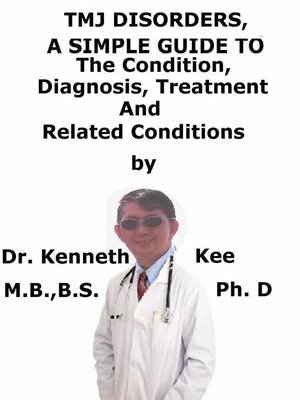TMJ Disorders, a Simple Guide to the Condition, Diagnosis, Treatment and Related Conditions
ebook
By Kenneth Kee

Sign up to save your library
With an OverDrive account, you can save your favorite libraries for at-a-glance information about availability. Find out more about OverDrive accounts.
Find this title in Libby, the library reading app by OverDrive.



Search for a digital library with this title
Title found at these libraries:
| Library Name | Distance |
|---|---|
| Loading... |
Temporomandibular joint and muscle disorders (TMJ disorders) are medical disorders that involve the chewing muscles and joints that connect the lower jaw to the skull.Temporomandibular joint disorders involve the jaw joint.The jaw joint is sited just in front of the ear and it connects the jaw bone (mandible) to the skull near to the temple.This particular jaw joint is known as the temporomandibular joint (TMJ).Medical conditions affecting this joint are typically called TMJ disorders.CausesThe two temporomandibular joints are similar and sited just in front of the ears on each side of the head.The results of physical stress on the structures around the joint are TMJ-related symptoms.These structures include:1. Cartilage disk at the joint2. Muscles of the jaw, face, and neck3. Nearby blood vessels, ligaments and nerves4. TeethTMJ disorders are believed to have multiple causes which mean that there are typically a number of risk factors contributing to the cause.These factors can be categorized into two forms:1. Problems linked to the muscles working the joint,2. Problems inside the joint itselfThe muscle problems are the most frequent form, especially for younger people.Conditions related to the muscles are:1. Over-activity of the jaw musclesSome rare kinds of movement disorders (called orofacial dystonias) can cause excessive jaw clenching.2. Increased sensitivity to pain.A higher sensitivity to pain can be related to mental stress or other process which involves pain sensitivity.3. Wear and tear to the inside of the jointWear and tear to the cartilage is due to a form of arthritis called osteoarthritis.4. Certain types of arthritis.Arthritis is the inflammation which occurs in a joint.5. Injury to the TMJ or to its cartilage disc can cause TMJ pain.6. Idiopathic TMJ cause: The cause in many people with temporomandibular joint disorders is unknown.Possible causes:1. A bad bite or orthodontic braces2. Stress and tooth grinding.The stress related to this disorder may be caused by the pain as opposed to being the cause of the problem.3. Poor posture can also be an important factor in TMJ symptoms.Symptoms of TMJ disorders:1. Jaw pain or tenderness of the jaw2. Dull, aching pain in the face3. Headache4. Biting or chewing difficulty or discomfort5. Difficulty opening or closing the mouth6. Locking of the jaw7. Clicking, popping, or grating sound when opening or closing the mouthDiagnosis:The diagnosis has been made based on the symptoms and a doctor's physical examination.A thorough examination will be required that involve:1. A dental exam to show if you have poor bite alignment2. Feeling the joint and muscles for tenderness3. Pressing around the head to locate areas that are sensitive or painful4. Sliding the teeth from side to side5. Watching, feeling, and listening to the jaw open and shutAn MRI scans which can be used to give a detailed picture of the joint.Arthroscopy of TMJ jointTreatment1. Simple, gentle therapies are recommended first.Physiotherapy methods such as how to gently stretch, relax, or massage muscles around the jaw are taught.2. Resting the joint3. Pain killers such as ibuprofen or codeine or paracetamol can relieve pain.Muscle relaxant also help to loosen the jaw muscles4. Moist heat or cold packs can be applied on the face.5. Stress-reducing techniques can be learned.6. Exercising several times each week may help you improve the ability to handle pain.Mouth splints or bite guards have been utilized to treat TMJ disorders.An injection of a steroid into the joint can reduce inflammation in the joint or botoxSurgical repair of the joint may be needed.TABLE OF CONTENTIntroductionChapter 1 TMJ DisordersChapter 2 CausesChapter 3 SymptomsChapter 4 DiagnosisChapter...







